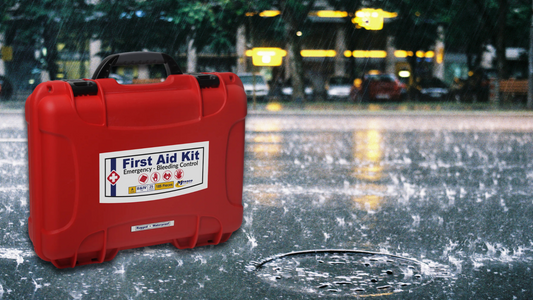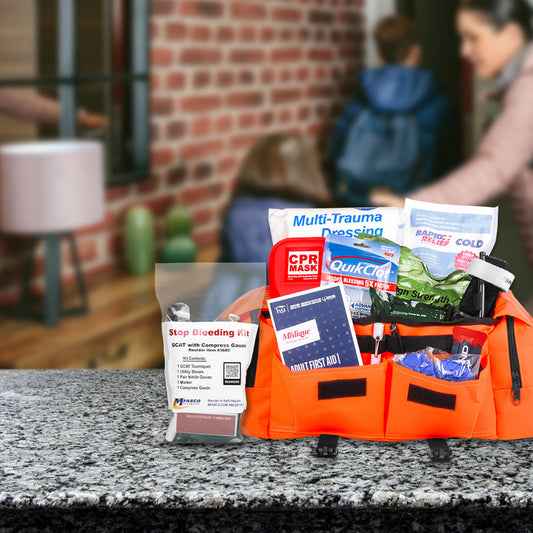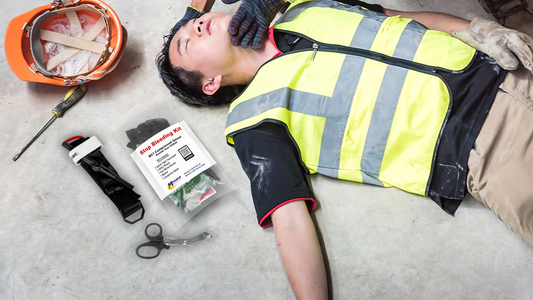The Critical First Moments: Why Every Staff Member Should Have Access to Bleeding Kits

The Need for Immediate Action in Emergencies
Emergencies can strike without warning, whether in a workplace, a school, or a public space. In such situations, severe bleeding is often one of the most life-threatening conditions that can occur. Every second matters; the first few minutes are critical, and without swift intervention, a person can bleed to death in as little as five minutes. This stark reality underscores the importance of ensuring that every staff member, regardless of their role, has immediate access to bleeding control kits and the training to use them.
Why Bleeding Kits Are Indispensable
Rapid Response Saves Lives
When it comes to severe bleeding, quick and effective action is non-negotiable. Severe blood loss can lead to hypovolemic shock, a condition that can become fatal within minutes if not addressed. Bleeding control kits, equipped with essential tools like tourniquets, hemostatic dressings, and compression bandages, allow individuals without medical training to take immediate action. This rapid response can stabilize a victim’s condition, significantly increasing their chances of survival until professional medical help arrives.
Accessibility for All Staff Members
Emergencies are unpredictable and can occur anywhere at any time. Relying solely on trained first responders, who may not always be present or may arrive too late, can lead to catastrophic delays. By ensuring that all staff members have access to bleeding kits, organizations can guarantee that help is available instantly, regardless of who is on duty or where an incident occurs. This proactive approach is particularly crucial in environments classified as "soft targets," such as schools and public buildings, where large numbers of people gather and security measures might be limited.
Empowering Staff Through Training
The Importance of Hands-On Practice
Having bleeding control kits available is only part of the solution. Staff members must also be trained to use them effectively. Programs like STOP THE BLEED® have educated millions worldwide on how to manage severe bleeding. Hands-on training builds confidence and prepares staff to act decisively in high-pressure situations. Without this training, even the best-equipped kit may be rendered useless by hesitation or improper use.
Integrating Bleeding Kits into Safety Protocols
To maximize the effectiveness of bleeding control kits, they must be integrated into the organization’s broader emergency preparedness plan. This integration should include regular drills and refresher courses to ensure that staff members remain familiar with the tools and techniques required to control severe bleeding. By embedding these practices into the safety culture of the organization, companies can maintain a state of readiness that is essential for effective emergency response.
Real-World Scenarios: The Difference Bleeding Kits Make
Workplace Incidents
Consider a manufacturing plant where heavy machinery is in use. A severe cut from machinery can lead to rapid blood loss. In such a scenario, the immediate application of a tourniquet or a hemostatic dressing can prevent a fatal outcome long before emergency medical services (EMS) arrive. The ability to act during these critical first moments can make all the difference.
School Emergencies
Schools are environments where accidents are both unpredictable and, at times, severe. Whether it’s a sports-related injury, a playground mishap, or a more serious incident, having bleeding kits accessible ensures that teachers and staff can respond effectively. This capability is especially vital in settings where children are present, as they are more vulnerable to severe injuries.
Legal and Ethical Considerations
The movement toward equipping workplaces and public spaces with bleeding control kits is not just about practicality—it’s also about fulfilling a growing ethical and legal obligation. Some states have already enacted legislation mandating that schools maintain and provide bleeding control equipment on campus. Additionally, the Occupational Safety and Health Administration (OSHA) has emphasized the importance of first aid training, which increasingly includes bleeding control techniques. By providing these kits, organizations are not only enhancing safety but also aligning with evolving legal standards and ethical expectations.
A Cost-Effective Life-Saving Measure
From a financial perspective, the cost of equipping an organization with bleeding control kits is minimal compared to the potential loss of life they help prevent. Many manufacturers now produce kits designed specifically for public use, making them both accessible and affordable for a wide range of organizations. Investing in these kits is a cost-effective way to significantly enhance the safety and preparedness of any workplace or public space.
Conclusion: Equip and Empower Your Team
Every organization has a responsibility to prioritize the safety of its members. By equipping all staff with bleeding control kits and the necessary training, organizations can ensure that they are prepared to respond effectively during those critical first moments of an emergency. The ability to act swiftly can save lives, prevent tragedies, and provide peace of mind to everyone involved. In an emergency, every second counts—make sure your team is ready to make them matter.
For more information on bleeding kits and how to integrate them into your safety plan, visit MFASCO Health & Safety.
Contributing Expert

Mike Brinker
Mike Brinker has been working in the first aid industry for over 35 years. He has worked with thousands of businesses,groups, and organizations to provide a healthy and safe work environment. Mike helped create “Make-A-Kit”, the internet's only online first aid kit creation tool. He has also authored many helpful first-aid and safety-related resource articles found at the MFASCO Learning Center.




